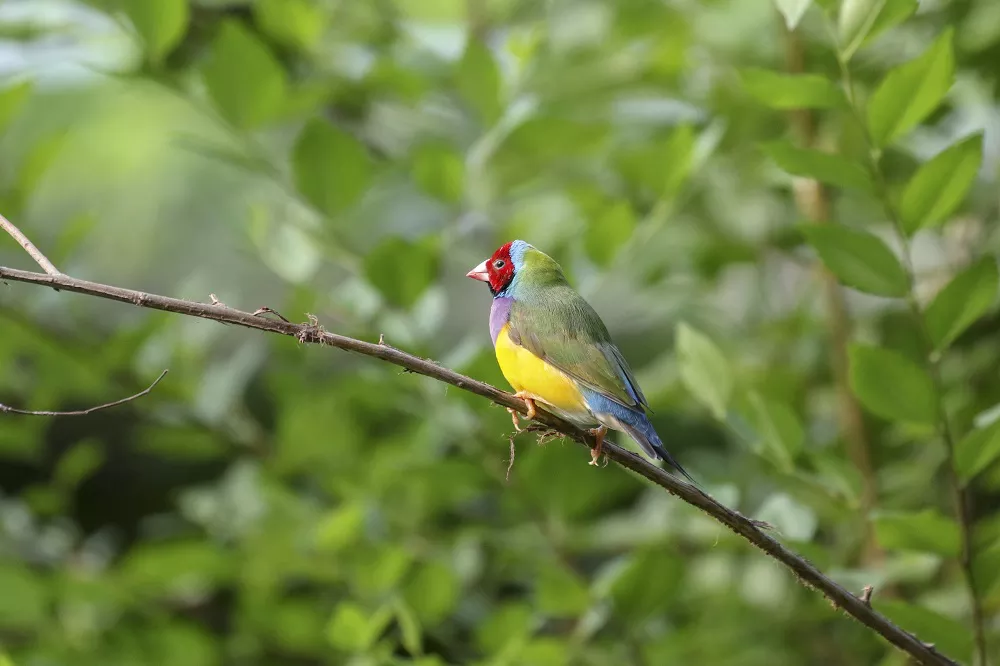The Gouldian Finch, also known as the Rainbow Finch or Lady Gouldian Finch, is a small, brightly-colored bird native to northern Australia. It is one of the most colorful birds in the world, with vibrant hues of red, green, yellow, and blue on its body, head, and wings. The Gouldian Finch is a popular pet bird due to its striking appearance and pleasant chirping, but it is also an endangered species in the wild. In this article, we will explore the natural habitat of the Gouldian Finch and its distribution across Australia.
Geographic Distribution
The Gouldian Finch is primarily found in the savanna woodlands of northern Australia, specifically in the Kimberley region of Western Australia, the Top End of the Northern Territory, and the Gulf Country of Queensland. These areas are characterized by a tropical climate with distinct wet and dry seasons. During the wet season, the Gouldian Finch can be found near water sources such as rivers, streams, and billabongs, while in the dry season, it seeks out grassy areas and open woodlands where it can feed on seeds and insects.
Habitat Preferences of Gouldian Finches
1. Grasslands and Woodlands:
Gouldian finches display a preference for open grasslands and woodlands. These habitats provide an ideal balance of grasses, shrubs, and scattered trees, offering both nesting sites and foraging opportunities. They are often found in areas with low tree density and moderate to tall grasses.
2. Savannahs and Riparian Zones:
Gouldian finches are also commonly found in savannah habitats, characterized by a mixture of grasses and scattered trees. Riparian zones, which are areas along rivers and watercourses, are particularly attractive to these finches due to the availability of water and diverse vegetation.
3. Fire-Maintained Habitats:
Gouldian finches have adapted to habitats that experience periodic fires. These fires help maintain the grassland and savannah ecosystems by promoting new growth and preventing the encroachment of woody vegetation. Gouldian finches are well adapted to take advantage of the post-fire regrowth, which provides abundant food resources and nesting opportunities.
4. Water Sources:
Access to water is critical for the survival of Gouldian finches. They rely on natural water sources such as rivers, billabongs (seasonal or permanent water bodies), and waterholes. These water sources not only provide drinking water but also attract insects, which form an important part of their diet.
Preferred Nesting Sites
Gouldian Finches typically nest in tree hollows, particularly those in eucalyptus trees. However, due to habitat loss and degradation, suitable nesting sites have become increasingly scarce. As a result, these birds have adapted to nesting in artificial nesting boxes provided by conservationists and bird enthusiasts. The use of nesting boxes has been successful in increasing the breeding success of Gouldian Finches in captivity and in the wild.
Conservation Status and Threats
Despite their popularity as pets, the Gouldian Finch is listed as endangered on the IUCN Red List. The population of these finches has declined significantly due to a combination of factors, including habitat loss, land degradation, altered fire regimes, and capture for the pet trade.
Conservation Efforts
Several conservation organizations and researchers are working diligently to conserve the Gouldian finch population and its habitat. Efforts include habitat restoration, targeted fire management, captive breeding programs, and public awareness campaigns to minimize the impact of the pet trade on wild populations. It is crucial to continue these conservation initiatives to ensure the long-term survival of this iconic species.
Conclusion
Conclusion
In conclusion, the Gouldian Finch is a colorful and charismatic bird that is native to the savanna woodlands of northern Australia. Its natural habitat consists of open grassy areas with eucalyptus and acacia trees, as well as access to freshwater sources. While the Gouldian Finch is popular as a pet bird, its wild populations are endangered due to habitat loss and predation. It is important to protect and conserve the natural habitat of this beautiful bird to ensure its survival for future generations.


 Facebook
Facebook  Instagram
Instagram  Youtube
Youtube 